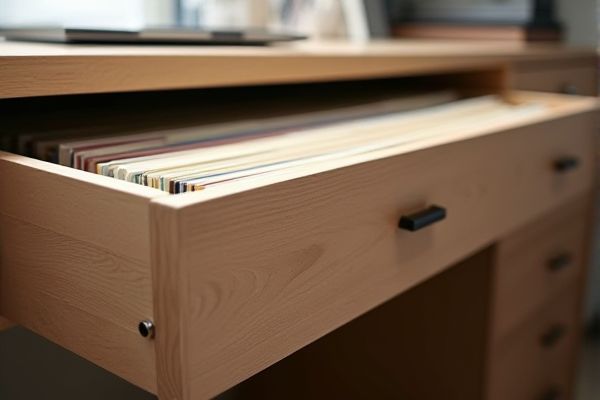
Under-desk drawers offer convenient, personal storage ideal for small office supplies and documents, while file drawers are designed for organized, vertical filing of larger documents and folders. Discover which option best suits your workspace needs by reading the rest of the article.
Table of Comparison
| Feature | Under-Desk Drawer | File Drawer |
|---|---|---|
| Primary Use | General storage of office supplies | Organized storage of hanging file folders |
| Placement | Mounted directly under the desk | Standalone or built-in filing cabinet |
| Storage Capacity | Limited space for small items | Large space optimized for documents |
| Security | Often includes lock options | Typically equipped with secure locking mechanisms |
| Mobility | Fixed; attached to desk | Varies; portable or fixed |
| Material | Metal, plastic, or wood | Usually metal or wood |
| Cost | Generally lower cost | Higher cost due to size and features |
Overview: Under-Desk Drawer vs. File Drawer
Under-desk drawers are compact storage units designed to fit directly beneath a desk, providing easy access to office supplies, documents, and personal items. File drawers, typically part of larger filing cabinets, are specifically engineered to store and organize hanging file folders for efficient document management. Choosing between an under-desk drawer and a file drawer depends on the need for space-saving convenience versus extensive file storage capacity.
Key Differences in Design
Under-desk drawers are compact, designed to fit snugly beneath your desk for easy access to smaller office supplies, while file drawers are larger, optimized for storing hanging file folders and important documents. The design of file drawers typically includes reinforced frames and full-extension slides to support heavier loads and frequent retrieval of files. Your choice depends on whether you need space for everyday essentials or extensive document organization.
Storage Capacity Comparison
Under-desk drawers typically offer limited storage capacity, designed for organizing small office supplies and documents within easy reach. File drawers are larger and built to hold a substantial volume of hanging file folders, accommodating bulky paperwork and extensive filing needs. Choosing between them depends on the amount of storage required and the type of items to be stored.
Accessibility and Convenience
Under-desk drawers offer superior accessibility by staying within arm's reach, making it easy to store and retrieve everyday office essentials quickly. File drawers typically provide more storage capacity but require standing or moving away from your workspace to access documents, which can interrupt workflow. Your choice depends on whether you prioritize immediate convenience or larger, organized file storage.
Best Uses for Under-Desk Drawers
Under-desk drawers are ideal for storing frequently accessed office supplies, personal items, and small documents that need to remain within arm's reach. They enhance workspace organization by providing compact storage without occupying additional floor space, making them suitable for tight office setups. These drawers are best used for tasks requiring quick retrieval and efficient space management, unlike file drawers that are designed for larger document storage and long-term archiving.
Best Uses for File Drawers
File drawers excel in organizing large volumes of documents and important files, making them ideal for office environments requiring accessible, categorized storage. Their vertical design accommodates standard letter and legal-size folders, maximizing space efficiency without cluttering desk surfaces. Robust construction and locking mechanisms enhance security for sensitive materials, ensuring both organization and confidentiality.
Space-Saving Considerations
Under-desk drawers optimize limited workspace by fitting directly beneath the desk, maximizing vertical space without increasing floor footprint. File drawers typically require more floor area but offer better capacity for organizing bulky documents and hanging files. Choosing between under-desk and file drawers depends on balancing the need for compact storage against the volume of paperwork to be stored efficiently.
Security and Privacy Features
Under-desk drawers typically offer basic security features such as lockable compartments to protect personal items, while file drawers often come equipped with more robust locking mechanisms designed to secure sensitive documents and confidential files. File drawers may include advanced privacy options like fire-resistant materials and tamper-proof locks to prevent unauthorized access, making them ideal for businesses handling sensitive information. Security standards such as ASTM F1236 for fire resistance are commonly met by file drawers, enhancing their reliability compared to standard under-desk drawers.
Material and Durability
Under-desk drawers typically feature lightweight materials like plastic or thin metal, offering moderate durability suitable for everyday office supplies but less resistance to heavy use. File drawers are often constructed from sturdy steel or hardwood, providing enhanced durability designed to withstand frequent filing and heavy contents over time. Your choice depends on whether you prioritize portability and compact storage or robust, long-lasting organization for important documents.
Choosing the Right Drawer for Your Workspace
Under-desk drawers offer compact storage for essential office supplies, enhancing organization without taking up extra floor space, making them ideal for small workspaces. File drawers provide larger capacity and are specifically designed to store documents and files systematically, ensuring easy access and better document preservation. Selecting the right drawer depends on your storage needs, available space, and the type of items you frequently use in your workspace.
 homyna.com
homyna.com